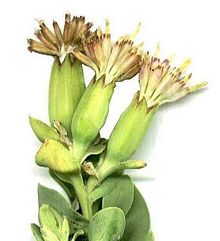Senecioneae
| Senecioneae | |
|---|---|

| |
| Lopholaena coriifolia | |
| Scientific classification | |
| Kingdom: | Plantae |
| Clade: | Tracheophytes |
| Clade: | Angiosperms |
| Clade: | Eudicots |
| Clade: | Asterids |
| Order: | Asterales |
| Family: | Asteraceae |
| Subfamily: | Asteroideae |
| Tribe: | Senecioneae Cass.
|
| Genera | |
|
See text | |
Senecioneae is the largest
Plants in this tribe are responsible for more livestock poisonings than all other plants combined.[4] Its members usually contain liver and kidney toxic and carcinogenic unsaturated pyrrolizidine alkaloids in Senecio[4] and furanoeremophilanes in Tetradymia.[3]
A number of species are well known in horticulture.[3]
Classification
Since the time of Bentham, the "premier systematic botanist of the nineteenth century",[5] considerable efforts have been made to classify and understand the striking morphological diversity in the Senecioneae.[2] The traditional view of the tribe has been that of one huge genus Senecio plus many other genera which exhibit varying degrees of distinctiveness.[5] Circumscription and delimitation of the tribe have experienced expansions and contractions over the decades as genera and groups of genera have been moved in and out,[3] as was the case for Arnica, Liabum, Munnozia, Schistocarpha, etc. which have since then been excluded.[5] Of the several potential causes for this constant redefinition the greatest is probably that little is known about its intergeneric relationships or a lack of phylogenetic understanding enhanced by the other problems of conflicting clues from morphological characters, the large size of the tribe, the absence of a precise delimitation or circumscription of Senecio[2] and the naturalness of these assemblages combined with the imprecise boundaries of the different species themselves.[5]
Many segregate genera have been recognized in recent studies, often with circumscriptions derived from selected representative species. Whether the recognition of numerous segregate genera provides a better taxonomy than treating the variation patterns as infrageneric taxa is yet unclear. A respectable case can be made for maintaining Senecio as a broad concept, at least until revisionary studies at the species level are carried out and the results subjected to critical analyses.[5] Most genera that have been removed from the Senecioneae in the broadest sense have come to rest within the
Genera
Senecioneae genera recognized by the Global Compositae Database as of October 2022[update]:[1]
- Abrotanella
- Acrisione
- Adenostyles
- Aequatorium
- Aetheolaena
- Angeldiazia
- Antillanthus
- Arbelaezaster
- Arnoglossum
- Arrhenechthites
- Austrosynotis
- Bafutia
- Barkleyanthus
- Bedfordia
- Bethencourtia
- Blennosperma
- Bolandia
- Brachionostylum
- Brachyglottis
- Cabreriella
- Cacaliopsis
- Cadiscus
- Capelio
- Caucasalia
- Caxamarca
- Centropappus
- Charadranaetes
- Chersodoma
- Cineraria
- Cissampelopsis
- Crassocephalum
- Cremanthodium
- Crocidium
- Culcitium
- Curio
- Dauresia
- Delairea
- Dendrocacalia
- Dendrophorbium
- Dendrosenecio
- Dicercoclados
- Digitacalia
- Dolichoglottis
- Dolichorrhiza
- Dorobaea
- Doronicum
- Dresslerothamnus
- Ekmaniopappus
- Elekmania
- Emilia
- Emiliella
- Endocellion
- Erechtites
- Eriotrix
- Euryops
- Farfugium
- Faujasia
- Faujasiopsis
- Garcibarrigoa
- Graphistylis
- Gymnodiscus
- Gynoxys
- Gynura
- Haastia
- Hasteola
- Herodotia
- Herreranthus
- Hertia
- Hoehnephytum
- Homogyne
- Hubertia
- Humbertacalia
- Ignurbia
- Io
- Iocenes
- Iranecio
- Ischnea
- Jacmaia
- Jacobaea
- Jessea
- Kleinia
- Lachanodes
- Lasiocephalus
- Lamprocephalus
- Leonis
- Lepidospartum
- Ligularia
- Ligulariopsis
- Lopholaena
- Lordhowea
- Luina
- Lundinia
- Mattfeldia
- Mesogramma
- Mesoneuris
- Mikaniopsis
- Miricacalia
- Misbrookea
- Mixtecalia
- Monticalia
- Nelsonianthus
- Nemosenecio
- Nesampelos
- Nordenstamia
- Odontocline
- Oldfeltia
- Oligothrix
- Oresbia
- Othonna
- Packera
- Papuacalia
- Paracalia
- Parafaujasia
- Paragynoxys
- Parasenecio
- Pentacalia
- Pericallis
- Petasites
- Phaneroglossa
- Pippenalia
- Pittocaulon
- Pladaroxylon
- Pojarkovia
- Psacaliopsis
- Psacalium
- Psednotrichia
- Pseudogynoxys
- Pseudojacobaea
- Rainiera
- Robinsonecio
- Robinsonia
- Roldana
- Rugelia
- Scapisenecio[6]
- Scrobicaria
- Senecio
- Senecurio
- Shafera
- Sinacalia
- Sinosenecio
- Solanecio
- Steirodiscus
- Stenops
- Stilpnogyne
- Syneilesis
- Synotis
- Talamancalia
- Telanthophora
- Tephroseris
- Tetradymia
- Traversia
- Trineuron
- Tussilago
- Urostemon
- Villasenoria
- Xenophyllum
- Yermo
- Zemisia
References
- ^ a b Compositae Working Group (CWG) (2023). "Senecioneae Cass." Global Compositae Database. Retrieved 2023-06-03.
- ^ JSTOR 25065905.
- ^ a b c d e Barkley, T.M.; Brouillet, L.; Strother, J.L. (2006). "Senecioneae". In Flora of North America Editorial Committee (ed.). Flora of North America North of Mexico (FNA). Vol. 20. New York and Oxford: Oxford University Press. Retrieved 2008-04-14 – via eFloras.org, Missouri Botanical Garden, St. Louis, MO & Harvard University Herbaria, Cambridge, MA.
- ^ PMID 21665692.
- ^ JSTOR 1221558.
- .
External links
 Media related to Senecioneae at Wikimedia Commons
Media related to Senecioneae at Wikimedia Commons Data related to Senecioneae at Wikispecies
Data related to Senecioneae at Wikispecies
